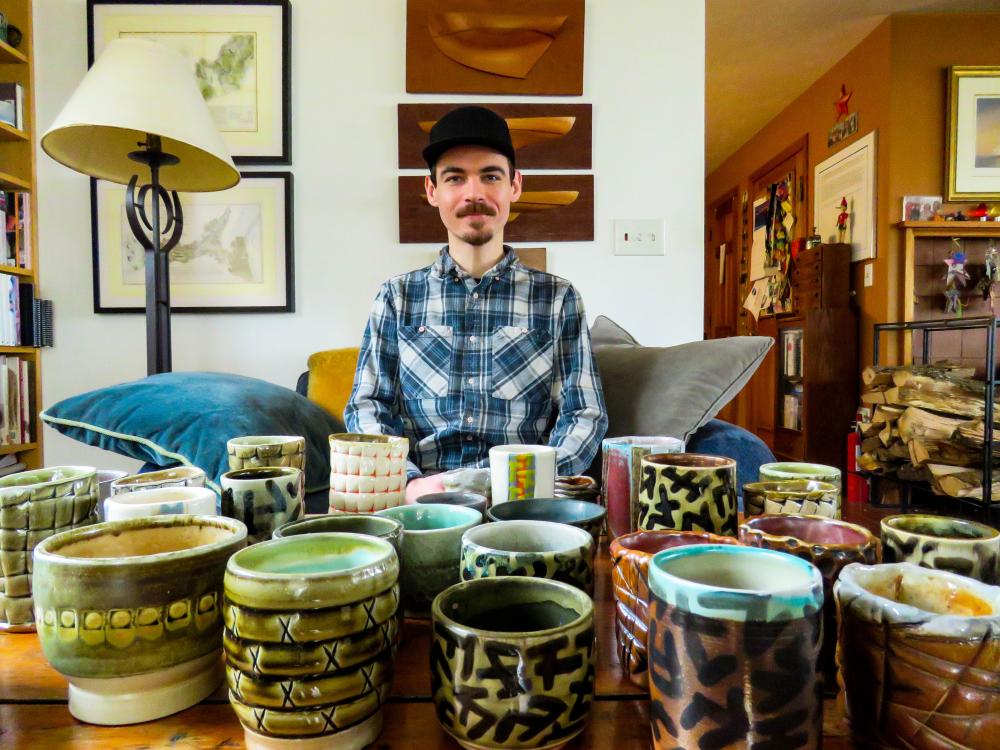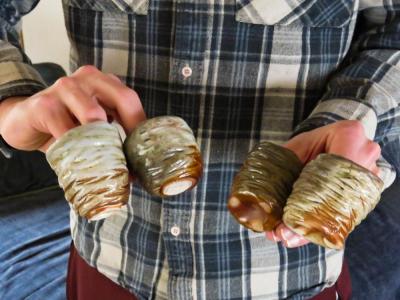Out of the kitchen and into the kiln

After graduating from art school, 32-year-old Wareham native Gordon Gleason spent seven years working in restaurants before returning to his passion — pottery, drawing and painting.
“By the end of it I just felt so crushed that I just kind of had the realization that working in restaurants, it's not going to get better,” Gleason said. “I’d been thinking for a while that I wanted to get back into the art world but I didn't really have the time or energy to do anything creative.”
While attempting to find a creative outlet, Gleason found Chris Gustin, a potter and former UMass Dartmouth professor, who owns and operates a ceramics studio in South Dartmouth.
In 2023 Gleason started working as a studio assistant for Gustin. The position gave Gleason an in, allowing him to enter the ceramics world under Gustin and learn the ins and outs of being a working artist, while creating his own work.
“[Gustin] is a big name in the ceramics world, he is in the majority of modern publications on ceramics and he does shows across the country,” Gleason said.
Gleason’s love of pottery didn’t start when he entered the South Dartmouth studio. While growing up in Wareham, he attended Tabor Academy in Marion, a high school with a ceramics program he described as “fantastic.”
He started ceramics work like most beginner students, with pinch-pots and small hand built pieces before eventually graduating to the throwing wheel, a tool used to mold clay by spinning it while the potter's hands shape it.
Those early pieces were fired in electric or gas kilns, the most common ovens for turning raw clay into finished ceramic.
But one of the kilns in Gustin’s studio is wood-fired, a much more delicate and intensive firing process that can create unique outcomes that have inspired Gleason’s recent work.
Operating the wood kiln is one of his many jobs at the studio. It requires splitting and stacking firewood that needs to be constantly fed into the oven.
The high heat of the kiln melts the ash introduced by the burning wood. That melted ash then creates a natural glaze that covers any unglazed pieces of pottery in the kiln.
The pieces produced by a wood kiln are desirable but the process is dangerous, often damaging the artwork. Because of this, Gleason said he needs to produce more work to accommodate potential losses.
“I’ve been finding stuff that is still interesting and fun to look at but I am able to accomplish much faster,” Gleason said.
Gleason said in general he doesn’t look for symmetry when creating a pottery piece.
“Difference in form is desirable for me, I don’t generally make things that are the same and when they are the same there is some variation to them,” Gleason said. “I don’t have an end product in mind when I start making. A lot of it is responding to the clay as I’m going.”
Ceramic work isn’t Gleason’s only artistic endeavor; he also paints on canvas and draws, with the latter becoming more frequent as he’s traveled the country for art shows while working for Gustin.
“Traveling with him I can’t bring canvases or clay with me so I'm drawing every second that I’m out there," Gleason said.
He said Gustin has encouraged him to translate the work from his sketchbook onto his ceramic pieces, something he has tried with some recent work and plans to do more of in the future.
Both his sketches and paintings are inspired by street artists and graffiti and primarily defined by geometric patterns and shapes.
“With ceramics there's a lot of traditional, both English and Japanese influence, whereas my paintings are much more inspired by graffiti and street art,” Gleason said. “I think they both are accessing different parts of my brain. But painting is very different from ceramics, when you’re applying a brush stroke, it's not going to melt and change color.”
He recently held his first solo art show in New Bedford on Sept. 12, 2024. On the first day of the show, Gleason said he sold a third of the painting he had on display.
“First solo I’ve ever done and it was great and it's something I definitely look forward to doing again,” Gleason said
Before his next show, he plans to experiment with larger ceramic pieces, ranging from two to three feet in height, and to translate his 2D work onto them.
“I can’t stop playing, a lot of it is experimental,” Gleason said.















